Emotional Landscapes in Urban Design: Analyzing Color Emotional Responses of the Elderly to Community Outdoor Spaces in Yi Jie Qu
Abstract
1. Introduction
1.1. Association between Color and Emotion
1.2. Color Emotion Classification
1.3. Factors Affecting Landscape Perception and Preference
1.4. Psychological Process of Space and Environment Perception
1.5. Research Gaps Identification and Study Aims
- Do the elderly exhibit overall emotional tendency toward color landscape of their community outdoor spaces?
- Are there significant positive CER differences between autumn and winter scenes of community outdoor spaces?
- Do color characteristics and individual factors significantly influence the positive CER of the elderly?
2. Theoretical Framework
2.1. Color Emotion Circumplex Model
2.2. Study Framework for CER Assessment of the Elderly toward Community Outdoor Spaces
3. Data and Methods
3.1. Case Study Area
3.2. Color Data Collection
3.3. Questionnaire Investigation
3.3.1. Color Screening Test
3.3.2. Survey of Individual and Visiting Factors
3.3.3. On-Site SD Experiment for CER Assessment
3.3.4. Acquisition Process of CER Values
3.4. Data Analysis and Variable Design
3.4.1. Overall CER Tendency of the Elderly toward Community Outdoor Spaces
3.4.2. Color Characteristics Analysis of Community Outdoor Spaces
3.4.3. Significant Difference in CER between Autumn and Winter
3.4.4. Effects of Individual and Color Characteristic Variables on Positive CER
3.5. Reliability and Validity Test
4. Results
4.1. Description Statistics
4.1.1. Demographic Statistics of the Elderly Respondents
4.1.2. Color Characteristics Statistics of the Community Outdoor Spaces
4.1.3. CER Assessment and Color Emotion Circumplex
- (1)
- CER-R value statistics
- (2)
- Color emotion circumplex of the elderly toward outdoor spaces in Yi Jie Qu
- (3)
- CER-S value statistics of eight community outdoor spaces
4.2. CER Differences between Autumn and Winter Scene
4.2.1. Paired-Sample t-Tests
4.2.2. CER-S Values Comparison between Autumn and Winter Scenes
4.3. The Effect of Individual Factors and Color Characteristics on CER
4.3.1. The Effect of Individual Factors on Positive CER
4.3.2. The Effect of Color Characteristic on Positive CER
5. Discussion
5.1. The Elderly Showed the Strongest CER toward Clean and Healthy Emotions
5.2. CER Differences Are Related to Seasonal Change
5.3. Effect of Individual Factors on Positive CER
5.4. Effect of Color Characteristics on Positive CER
5.5. Limitation
6. Conclusions
Author Contributions
Funding
Data Availability Statement
Acknowledgments
Conflicts of Interest
References
- He, D.; Miao, J.; Lu, Y.; Song, Y.; Chen, L.; Liu, Y. Urban Greenery Mitigates the Negative Effect of Urban Density on Older Adults’ Life Satisfaction: Evidence from Shanghai, China. Cities 2022, 124, 103607. [Google Scholar] [CrossRef]
- Jayantha, W.M.; Qian, Q.K.; Yi, C.O. Applicability of ‘Aging in Place’ in Redeveloped Public Rental Housing Estates in Hong Kong. Cities 2018, 83, 140–151. [Google Scholar] [CrossRef]
- Bustamante, G.; Guzman, V.; Kobayashi, L.C.; Finlay, J. Mental Health and Well-Being in Times of COVID-19: A Mixed-Methods Study of the Role of Neighborhood Parks, Outdoor Spaces, and Nature among US Older Adults. Health Place 2022, 76, 102813. [Google Scholar] [CrossRef]
- Sugiyama, T.; Ward Thompson, C. Older People’s Health, Outdoor Activity and Supportiveness of Neighbourhood Environments. Landsc. Urban Plan. 2007, 83, 168–175. [Google Scholar] [CrossRef]
- Zhang, D.; Jin, X.; Wang, L.; Jin, Y. Form and Color Visual Perception in Green Exercise: Positive Effects on Attention, Mood, and Self-Esteem. J. Environ. Psychol. 2023, 88, 102028. [Google Scholar] [CrossRef]
- He, F.; He, Y.; Sun, L. Gender Differences in Color Perceptions and Preferences of Urban Façades Based on a Virtual Comparison. Build. Environ. 2023, 245, 110907. [Google Scholar] [CrossRef]
- Wang, Z.; Sun, H.; Li, J. Research on Architectural Color and Visual Comfort in Historic Landscape Areas. Buildings 2023, 13, 1004. [Google Scholar] [CrossRef]
- Adams, F.M.; Osgood, C.E. A cross-cultural study of the affective meanings of color. J. Cross-Cult. Psychol. 1973, 4, 135–157. [Google Scholar] [CrossRef]
- Yu, C.-E.; Xie, S.Y.; Wen, J. Coloring the Destination: The Role of Color Psychology on Instagram. Tour. Manag. 2020, 80, 104110. [Google Scholar] [CrossRef]
- Wei, Y.; Zhang, Y.; Wang, Y.; Liu, C. A Study of the Emotional Impact of Interior Lighting Color in Rural Bed and Breakfast Space Design. Buildings 2023, 13, 2537. [Google Scholar] [CrossRef]
- Zhang, L.; Dempsey, N.; Cameron, R. Flowers—Sunshine for the Soul! How Does Floral Colour Influence Preference, Feelings of Relaxation and Positive Up-Lift? Urban For. Urban Green. 2023, 79, 127795. [Google Scholar] [CrossRef]
- Mammarella, N.; Di Domenico, A.; Palumbo, R.; Fairfield, B. When Green Is Positive and Red Is Negative: Aging and the Influence of Color on Emotional Memories. Psychol. Aging 2016, 31, 914–926. [Google Scholar] [CrossRef]
- Güneş, E.; Olguntürk, N. Color-emotion Associations in Interiors. Color Res. Appl. 2020, 45, 129–141. [Google Scholar] [CrossRef]
- Elliot, A.J.; Maier, M.A. Color Psychology: Effects of Perceiving Color on Psychological Functioning in Humans. Annu. Rev. Psychol. 2014, 65, 95–120. [Google Scholar] [CrossRef]
- Jonauskaite, D.; Camenzind, L.; Parraga, C.A.; Diouf, C.N.; Mercapide Ducommun, M.; Müller, L.; Norberg, M.; Mohr, C. Colour-Emotion Associations in Individuals with Red-Green Colour Blindness. PeerJ 2021, 9, e11180. [Google Scholar] [CrossRef]
- Takei, A.; Imaizumi, S. Effects of Color–Emotion Association on Facial Expression Judgments. Heliyon 2022, 8, e08804. [Google Scholar] [CrossRef]
- Hanada, M. Correspondence Analysis of Color–Emotion Associations. Color Res. Appl. 2018, 43, 224–237. [Google Scholar] [CrossRef]
- Russell, J.A.; Lanius, U.F. Adaptation Level and the Affective Appraisal of Environments. J. Environ. Psychol. 1984, 4, 119–135. [Google Scholar] [CrossRef]
- Russell, J.A.; Pratt, G. A Description of the Affective Quality Attributed to Environments. J. Personal. Soc. Psychol. 1980, 38, 311–322. [Google Scholar] [CrossRef]
- Chon, J.; Scott Shafer, C. Aesthetic Responses to Urban Greenway Trail Environments. Landsc. Res. 2009, 34, 83–104. [Google Scholar] [CrossRef]
- Hoyle, H.; Hitchmough, J.; Jorgensen, A. All about the ‘Wow Factor’? The Relationships between Aesthetics, Restorative Effect and Perceived Biodiversity in Designed Urban Planting. Landsc. Urban Plan. 2017, 164, 109–123. [Google Scholar] [CrossRef]
- Graphi-Sha Publishing. A Complete Guide to Digital Color Design; Graphi-Sha Publishing: Tokyo, Japan, 2018. [Google Scholar]
- Jia, H.; Luo, P.; Yang, H.; Luo, C.; Li, H.; Wu, S.; Cheng, Y.; Huang, Y.; Xie, W. Exploring the Relationship between Forest Scenic Beauty with Color Index and Ecological Integrity: Case Study of Jiuzhaigou and Giant Panda National Park in Sichuan, China. Forests 2022, 13, 1883. [Google Scholar] [CrossRef]
- Zhang, L.; Li, X.; Li, C.; Zhang, T. Research on Visual Comfort of Color Environment Based on the Eye-Tracking Method in Subway Space. J. Build. Eng. 2022, 59, 105138. [Google Scholar] [CrossRef]
- Hegde, A.L.; Bishop, N. Saturation Based Color Appearance of Objects: A Comparison between Healthy Elderly, Young Adults, and Young Adults Wearing Goggles Simulating Cataract. Build. Environ. 2018, 127, 148–156. [Google Scholar] [CrossRef]
- Lengen, C. The Effects of Colours, Shapes and Boundaries of Landscapes on Perception, Emotion and Mentalising Processes Promoting Health and Well-Being. Health Place 2015, 35, 166–177. [Google Scholar] [CrossRef]
- Zhang, Y.; Liu, P.; Han, B.; Xiang, Y.; Li, L. Hue, chroma, and lightness preference in Chinese adults: Age and gender differences. Color Res. Appl. 2019, 44, 967–998. [Google Scholar] [CrossRef]
- Howley, P. Landscape Aesthetics: Assessing the General Publics’ Preferences towards Rural Landscapes. Ecol. Econ. 2011, 72, 161–169. [Google Scholar] [CrossRef]
- Hegetschweiler, K.T.; Wartmann, F.; Dubernet, I.; Hunziker, M. Urban Forest Usage and Perception of Ecosystem Services—A Comparison between Teenagers and Adults. Urban For. Urban Green. 2022, 74, 127624. [Google Scholar] [CrossRef]
- Nolé Fajardo, M.L.; Higuera-Trujillo, J.L.; Llinares, C. Lighting, Colour and Geometry: Which Has the Greatest Influence on Students’ Cognitive Processes? Front. Archit. Res. 2023, 12, 575–586. [Google Scholar] [CrossRef]
- Gan, Y.; Zheng, Y.; Zhang, L. Audio-Visual Analysis of Visitors’ Landscape Preference for City Parks: A Case Study from Zhangzhou, China. Forests 2022, 13, 1376. [Google Scholar] [CrossRef]
- Chen, S.; Liu, L.; Chen, C.; Haase, D. The Interaction between Human Demand and Urban Greenspace Supply for Promoting Positive Emotions with Sentiment Analysis from Twitter. Urban For. Urban Green. 2022, 78, 127763. [Google Scholar] [CrossRef]
- Svobodova, K.; Sklenicka, P.; Molnarova, K.; Salek, M. Visual preferences for physical attributes of mining and post-mining landscapes with respect to the sociodem-ographic characteristics of respondents. Ecol. Eng. 2012, 43, 34–44. [Google Scholar] [CrossRef]
- Müderrisoğlu, H.; Gültekin, P.G. Understanding the Children’s Perception and Preferences on Nature-Based Outdoor Landscape. Indoor Built Environ. 2015, 24, 340–354. [Google Scholar] [CrossRef]
- Van Den Berg, A.E.; Koole, S.L. New Wilderness in the Netherlands: An Investigation of Visual Preferences for Nature Development Landscapes. Landsc. Urban Plan. 2006, 78, 362–372. [Google Scholar] [CrossRef]
- Hu, K.; Xu, Z.; Wang, X.; Wang, Y.; Li, H.; Zhang, Y. Research on Street Color Environment Perception Based on CEP-KASS Framework. Buildings 2023, 13, 2649. [Google Scholar] [CrossRef]
- Howley, P.; Donoghue, C.O.; Hynes, S. Exploring Public Preferences for Traditional Farming Landscapes. Landsc. Urban Plan. 2012, 104, 66–74. [Google Scholar] [CrossRef]
- Wang, Q.; Yang, X.; Liu, X.; Furuya, K. Rice Terrace Experience in Japan: An Ode to the Beauty of Seasonality and Nostalgia. Land 2024, 13, 64. [Google Scholar] [CrossRef]
- Peng, Y.; Gan, D.; Cai, Z.; Xiao, M.; Shu, D.; Wu, C.; Yu, X.; Li, X. Landscape Features Impact the Spatial Heterogeneity of Visitation Density within a Comprehensive Park: What Are the Seasonal and Diurnal Variations? Forests 2023, 14, 1627. [Google Scholar] [CrossRef]
- Yuan, S.; Browning, M.H.E.M.; McAnirlin, O.; Sindelar, K.; Shin, S.; Drong, G.; Hoptman, D.; Heller, W. A Virtual Reality Investigation of Factors Influencing Landscape Preferences: Natural Elements, Emotions, and Media Creation. Landsc. Urban Plan. 2023, 230, 104616. [Google Scholar] [CrossRef]
- Russell, J.A.; Ward, L.M. Environmental psychology. Annu. Rev. Psychol. 1982, 33, 651–689. [Google Scholar] [CrossRef]
- Gifford, R. Environmental psychology matters. Annu. Rev. Psychol. 2014, 65, 541–579. [Google Scholar] [CrossRef]
- De Groot, J.I. Environmental Psychology: An Introduction, 2nd ed; John Wiley & Sons Ltd: Chichester, UK, 2019; pp. 157–217. [Google Scholar]
- Ma, B.; Hauer, R.J.; Xu, C. Effects of Design Proportion and Distribution of Color in Urban and Suburban Green Space Planning to Visual Aesthetics Quality. Forests 2020, 11, 278. [Google Scholar] [CrossRef]
- Xu, T.; Wang, S.; Liu, Q.; Kim, J.; Zhang, J.; Ren, Y.; Ta, N.; Wang, X.; Wu, J. Vegetation Color Exposure Differences at the Community and Individual Levels: An Explanatory Framework Based on the Neighborhood Effect Averaging Problem. Urban For. Urban Green. 2023, 86, 128001. [Google Scholar] [CrossRef]
- Šprah, N.; Potočnik, J.; Košir, M. The Influence of Façade Colour, Glazing Area and Geometric Configuration of Urban Canyon on the Spectral Characteristics of Daylight. Build. Environ. 2024, 251, 111214. [Google Scholar] [CrossRef]
- Vera-Villarroel, P.; Contreras, D.; Lillo, S.; Beyle, C.; Segovia, A.; Rojo, N.; Moreno, S.; Oyarzo, F. Perception of Safety and Liking Associated to the Colour Intervention of Bike Lanes: Contribution from the Behavioural Sciences to Urban Design and Wellbeing. PLoS ONE 2016, 11, e0160399. [Google Scholar] [CrossRef]
- Torres, A.; Serra, J.; Llopis, J.; Delcampo, A. Color preference cool versus warm in nursing homes depends on the expected activity for interior spaces. Front. Archit. Res. 2020, 9, 739–750. [Google Scholar] [CrossRef]
- Wang, C.; Leung, M. Effects of Subjective Perceptions of Indoor Visual Environment on Visual-Related Physical Health of Older People in Residential Care Homes. Build. Environ. 2023, 237, 110301. [Google Scholar] [CrossRef]
- Wan, J.; Wu, H.; Collins, R.; Deng, K.; Zhu, W.; Xiao, H.; Tang, X.; Tian, C.; Zhang, C.; Zhang, L. Integrative Analysis of Health Restoration in Urban Blue-Green Spaces: A Multiscale Approach to Community Park. J. Clean. Prod. 2024, 435, 140178. [Google Scholar] [CrossRef]
- Osgood, C.E. Exploration in semantic space: A personal diary 1. J. Soc. Issues 1971, 27, 5–64. [Google Scholar] [CrossRef]
- Li, Z.; Sun, X.; Zhao, S.; Zuo, H. Integrating Eye-Movement Analysis and the Semantic Differential Method to Analyze the Visual Effect of a Traditional Commercial Block in Hefei, China. Front. Archit. Res. 2021, 10, 317–331. [Google Scholar] [CrossRef]
- Arriaza, M.; Cañas-Ortega, J.F.; Cañas-Madueño, J.A.; Ruiz-Aviles, P. Assessing the Visual Quality of Rural Landscapes. Landsc. Urban Plan. 2004, 69, 115–125. [Google Scholar] [CrossRef]
- Wade, M.T.; Julian, J.P.; Jeffery, K.S.; Davidson, S.M. A Participatory Approach to Assess Social Demand and Value of Urban Waterscapes: A Case Study in San Marcos, Texas, USA. Land 2023, 12, 1137. [Google Scholar] [CrossRef]
- Ma, B.; Hauer, R.J.; Xu, C.; Li, W. Visualizing Evaluation Model of Human Perceptions and Characteristic Indicators of Landscape Visual Quality in Urban Green Spaces by Using Nomograms. Urban For. Urban Green. 2021, 65, 127314. [Google Scholar] [CrossRef]
- Lak, A.; Aghamolaei, R.; Baradaran, H.R.; Myint, P.K. A Framework for Elder-Friendly Public Open Spaces from the Iranian Older Adults’ Perspectives: A Mixed-Method Study. Urban For. Urban Green. 2020, 56, 126857. [Google Scholar] [CrossRef]
- Potter, J.D.; Brooks, C.; Donovan, G.; Cunningham, C.; Douwes, J. A Perspective on Green, Blue, and Grey Spaces, Biodiversity, Microbiota, and Human Health. Sci. Total Environ. 2023, 892, 164772. [Google Scholar] [CrossRef]
- Kuper, R. Effects of Flowering, Foliation, and Autumn Colors on Preference and Restorative Potential for Designed Digital Landscape Models. Environ. Behav. 2020, 52, 544–576. [Google Scholar] [CrossRef]
- Wu, L.; Luo, S.; Li, D.; Chen, Q.; Li, J.; Wen, J. Effects of Deciduous Forests on Adolescent Emotional Health in Urban Areas: An Example from the Autumn Ginkgo Forest in Chengdu. Forests 2023, 14, 1099. [Google Scholar] [CrossRef]
- Chen, C.; Guo, P. Can Indoor Residents Perceive Green and Blue Spaces in Communities as Posted Sentiments? A Verification in Nanchang. Forests 2022, 13, 1421. [Google Scholar] [CrossRef]
- Wang, R.; Zhao, J. Demographic Groups’ Differences in Visual Preference for Vegetated Landscapes in Urban Green Space. Sustain. Cities Soc. 2017, 28, 350–357. [Google Scholar] [CrossRef]
- Miljanovic Damjanovic, V.; Obradovic Salcin, L.; Ostojic, D.; Ostojic, L.; Gilic, B.; Geets Kesic, M.; Uzicanin, E.; Sekulic, D. Exploring Factors Associated with Physical Activity in the Elderly: A Cross-Sectional Study during the COVID-19 Pandemic. Behav. Sci. 2024, 14, 62. [Google Scholar] [CrossRef]
- Inoue, T.; Manabe, R.; Murayama, A.; Koizumi, H. Landscape Value in Urban Neighborhoods: A Pilot Analysis Using Street-Level Images. Landsc. Urban Plan. 2022, 221, 104357. [Google Scholar] [CrossRef]
- Zhang, T.; Zhang, W.; Meng, H.; Zhang, Z. Analyzing Visitors’ Preferences and Evaluation of Satisfaction Based on Different Attributes, with Forest Trails in the Akasawa National Recreational Forest, Central Japan. Forests 2019, 10, 431. [Google Scholar] [CrossRef]
- Mao, Y.; Kubo, T. Everyday Activities of Older Adults in Tianjin, China: Coupling Constraints, Gendered Mobilities and Social Context. Behav. Sci. 2023, 13, 996. [Google Scholar] [CrossRef]
- Naghibi, M.; Faizi, M. Temporary Reuse in Leftover Spaces through the Preferences of the Elderly. Cities 2022, 127, 103769. [Google Scholar] [CrossRef]
- Subramanian, D.; Jana, A. Assessing Urban Recreational Open Spaces for the Elderly: A Case of Three Indian Cities. Urban For. Urban Green. 2018, 35, 115–128. [Google Scholar] [CrossRef]
- Tao, W.; Wu, Y.; Li, W.; Liu, F. Influence of Classroom Colour Environment on College Students’ Emotions during Campus Lockdown in the COVID-19 Post-Pandemic Era—A Case Study in Harbin, China. Buildings 2022, 12, 1873. [Google Scholar] [CrossRef]
- Jonauskaite, D.; Parraga, C.A.; Quiblier, M.; Mohr, C. Feeling Blue or Seeing Red? Similar Patterns of Emotion Associations with Colour Patches and Colour Terms. i-Perception 2020, 11, 2041669520902484. [Google Scholar] [CrossRef]
- Li, H.; Peng, J.; Jiao, Y.; Ai, S. Experiencing Urban Green and Blue Spaces in Urban Wetlands as a Nature-Based Solution to Promote Positive Emotions. Forests 2022, 13, 473. [Google Scholar] [CrossRef]
- Smith, N.; Georgiou, M.; King, A.C.; Tieges, Z.; Webb, S.; Chastin, S. Urban Blue Spaces and Human Health: A Systematic Review and Meta-Analysis of Quantitative Studies. Cities 2021, 119, 103413. [Google Scholar] [CrossRef]
- Demir, Ü. Investigation of Color-Emotion Associations of the University Students. Color Res. Appl. 2020, 45, 871–884. [Google Scholar] [CrossRef]
- Zhao, W.; Li, X.; Zhu, X.; Ye, H.; Xu, H. Restorative Properties of Green Sheltered Spaces and Their Morphological Characteristics in Urban Parks. Urban For. Urban Green. 2023, 86, 127986. [Google Scholar] [CrossRef]
- Zhou, X.; Cen, Q.; Qiu, H. Effects of Urban Waterfront Park Landscape Elements on Visual Behavior and Public Preference: Evidence from Eye-Tracking Experiments. Urban For. Urban Green. 2023, 82, 127889. [Google Scholar] [CrossRef]

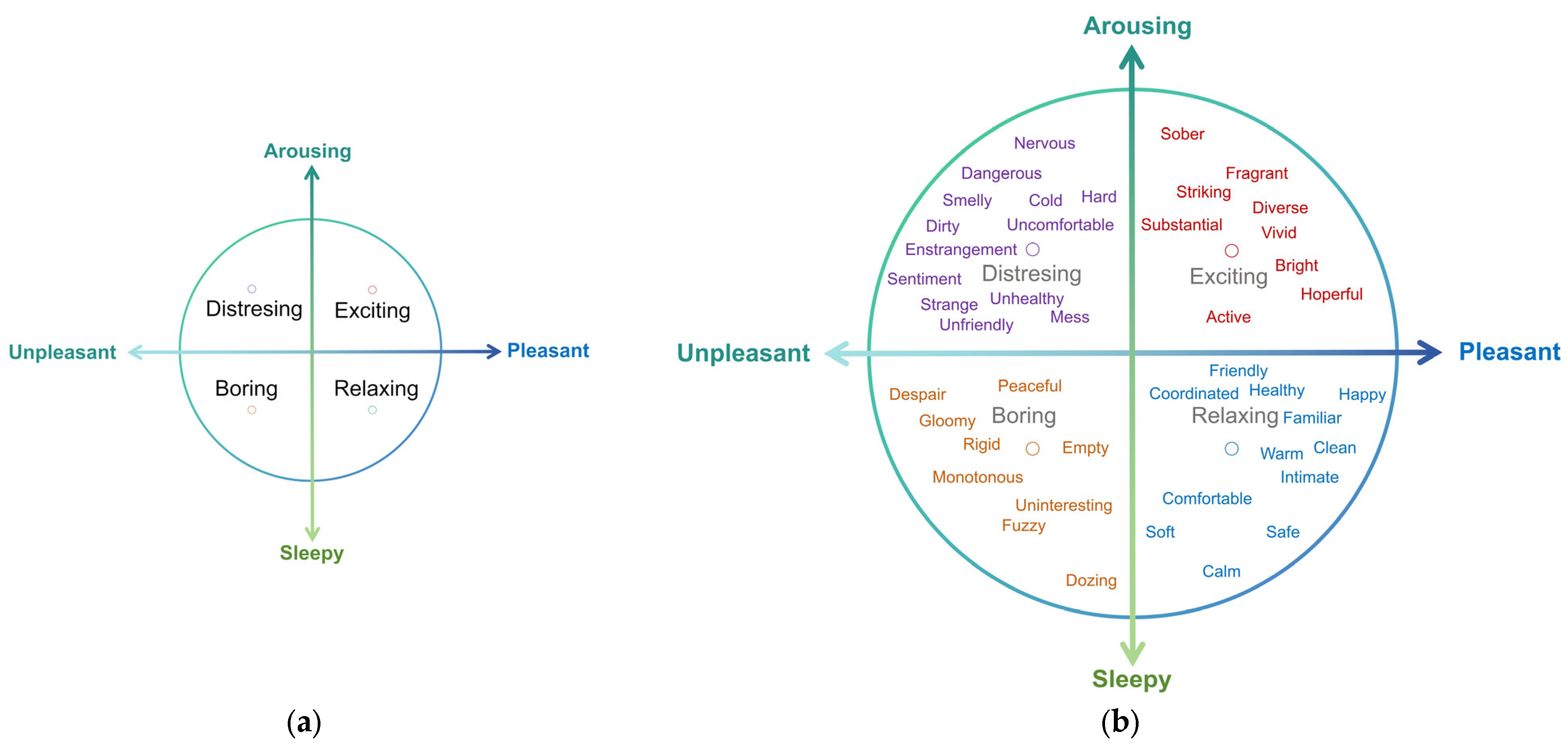
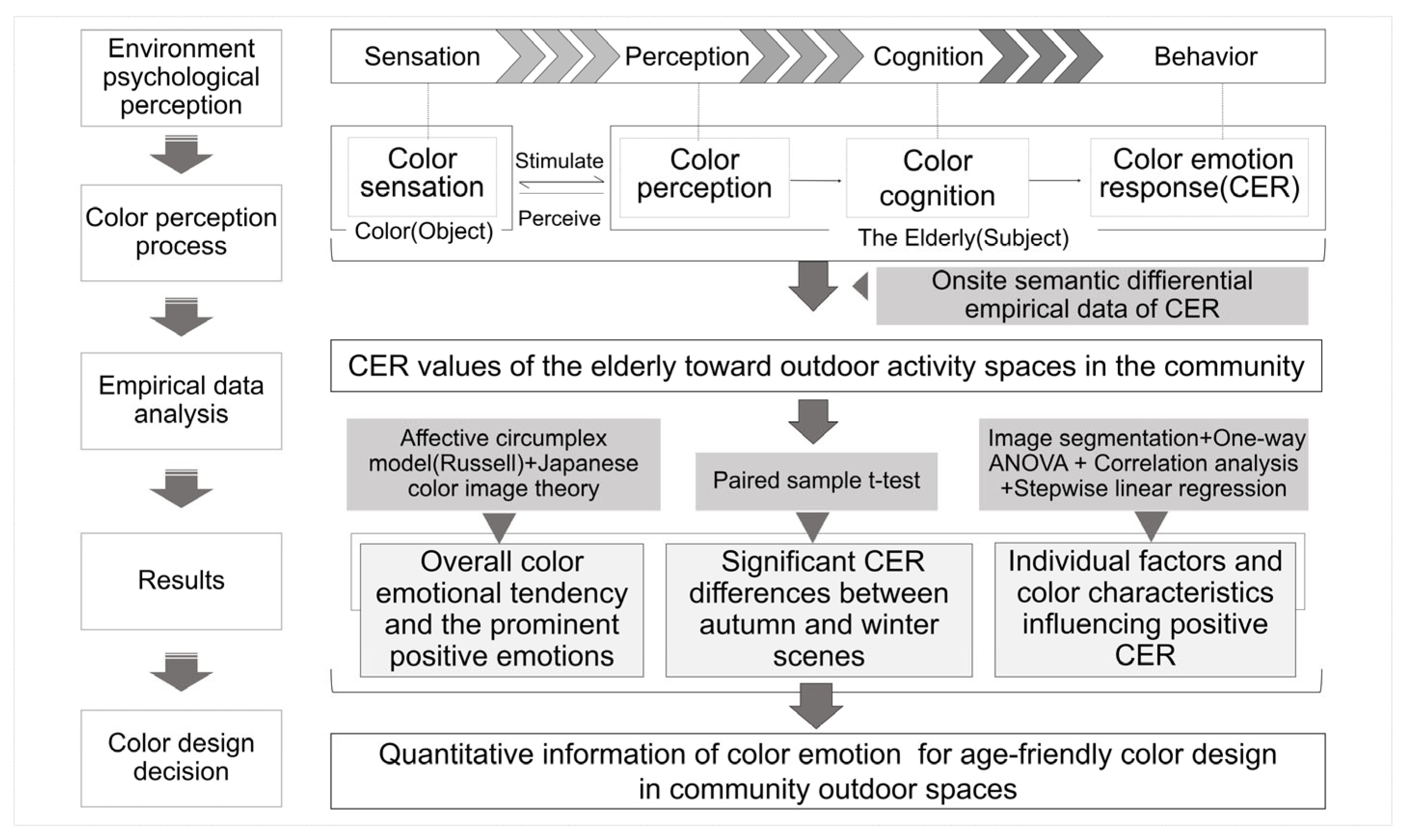
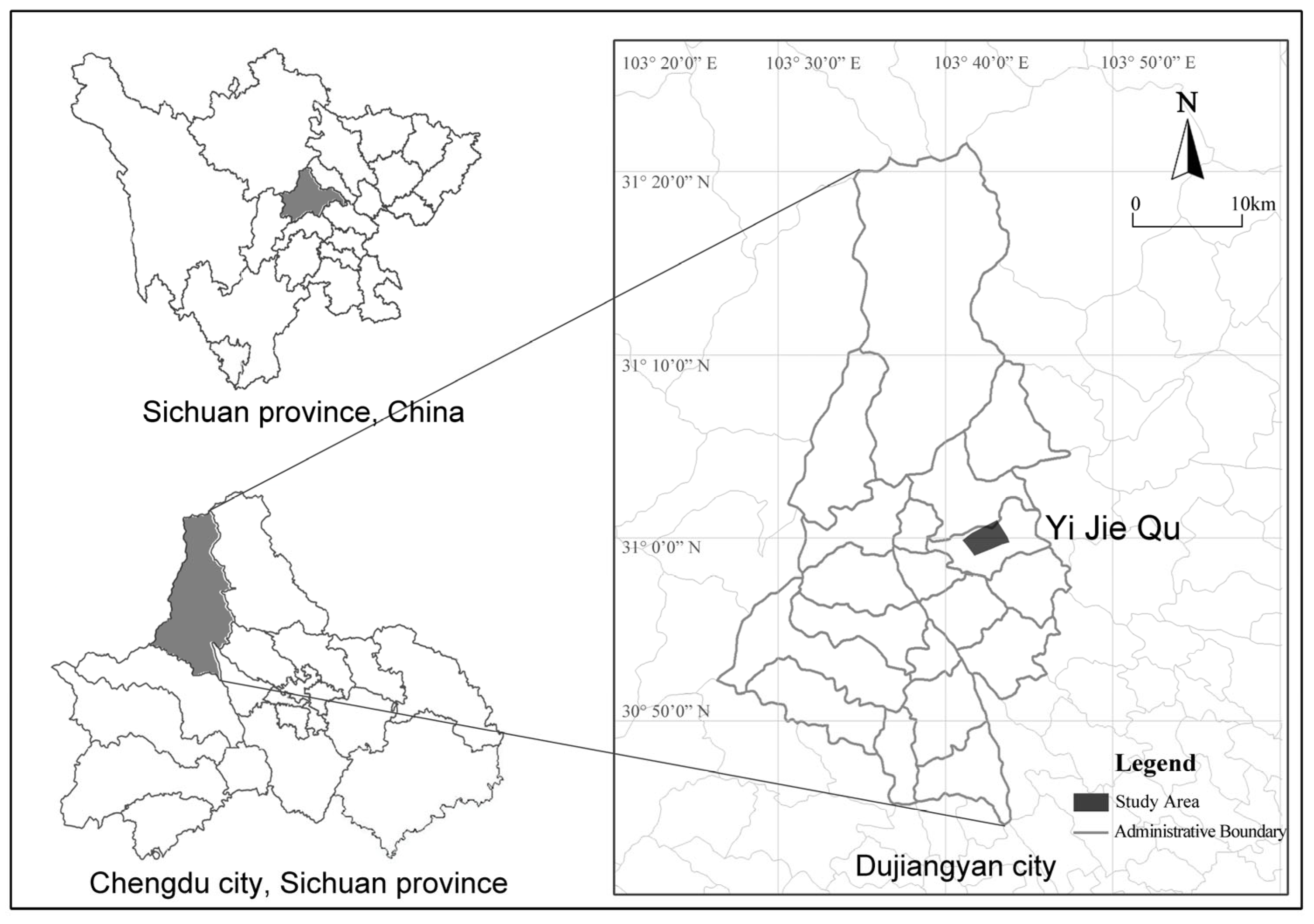

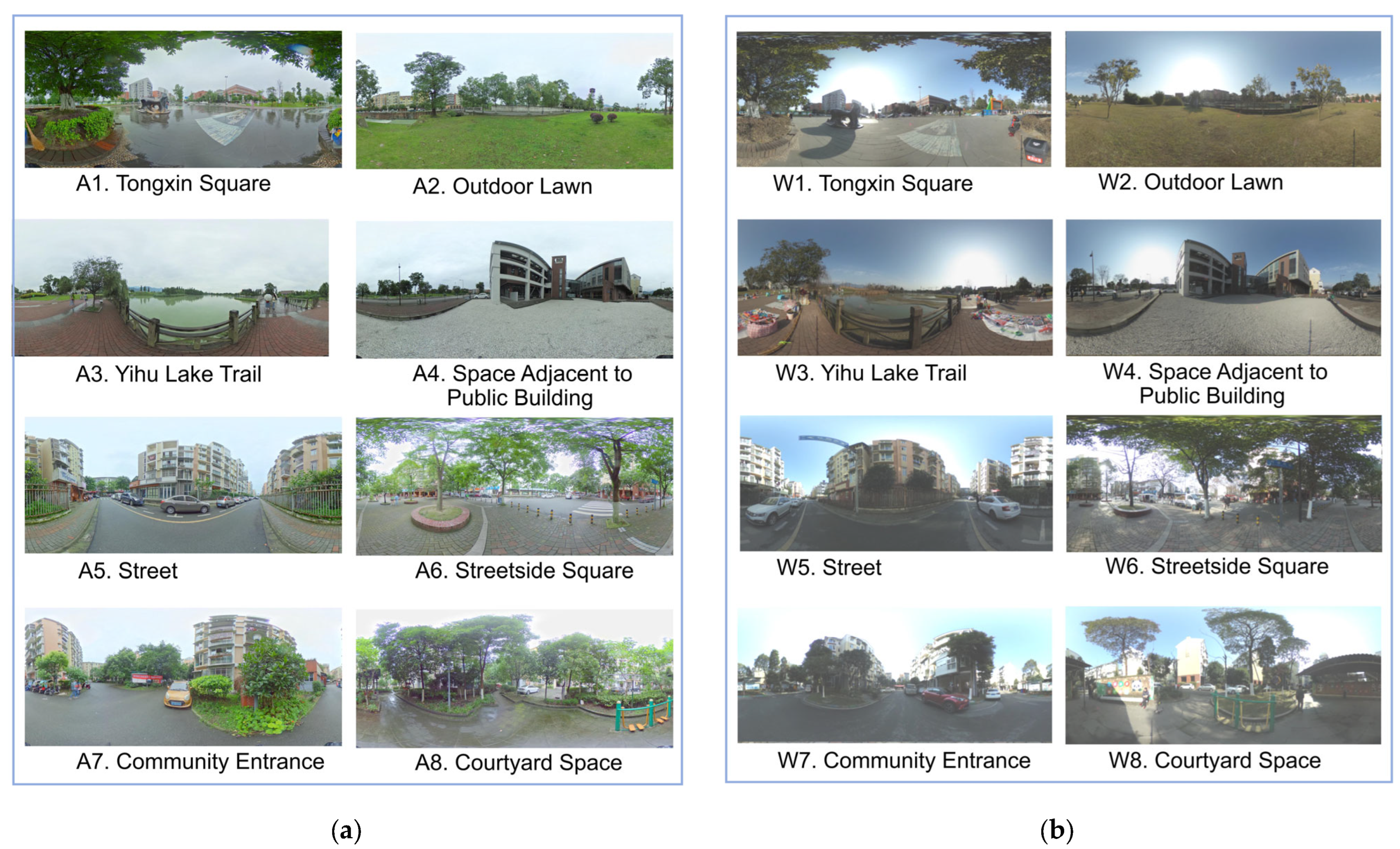

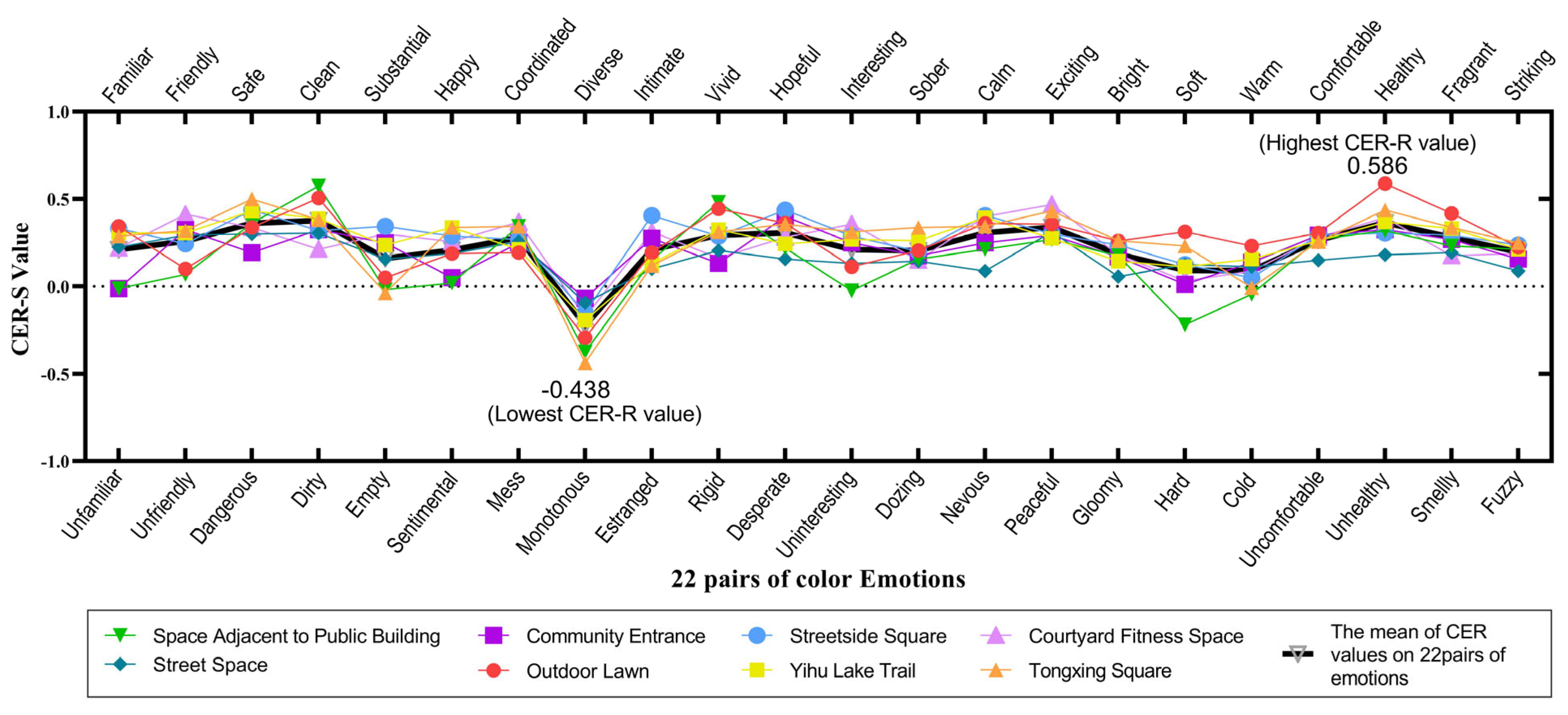
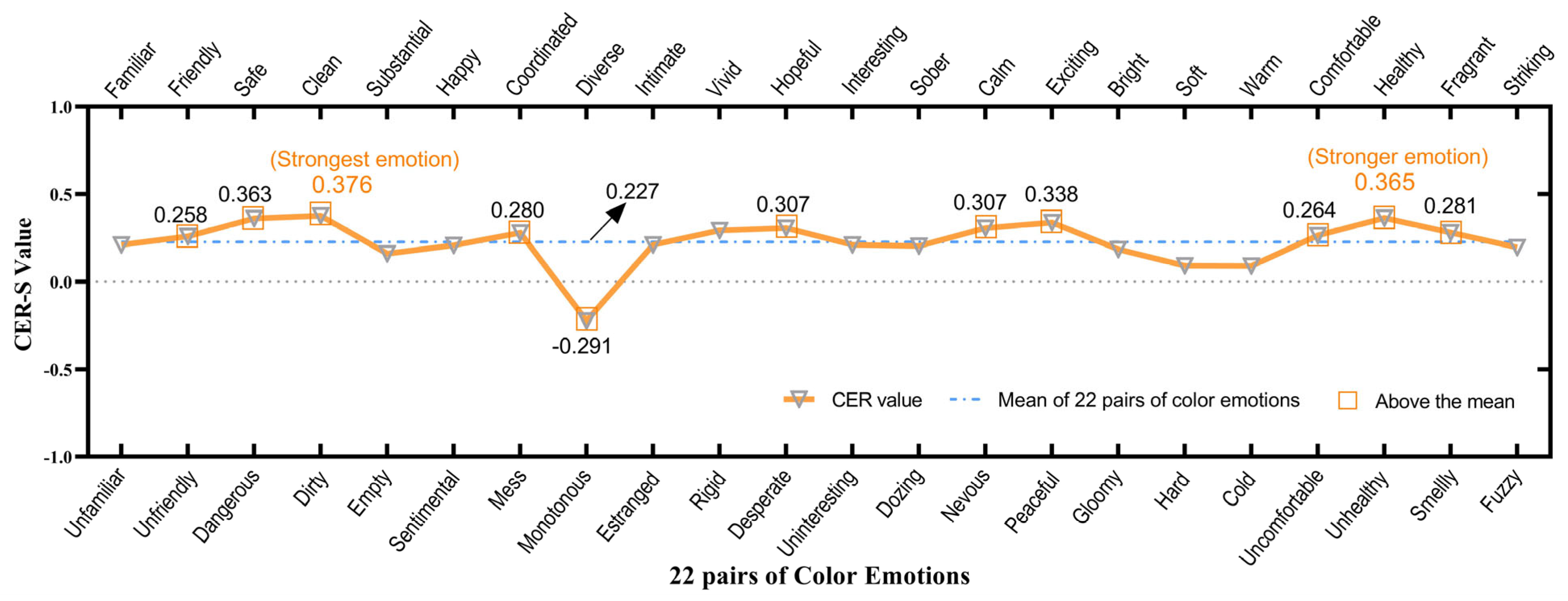
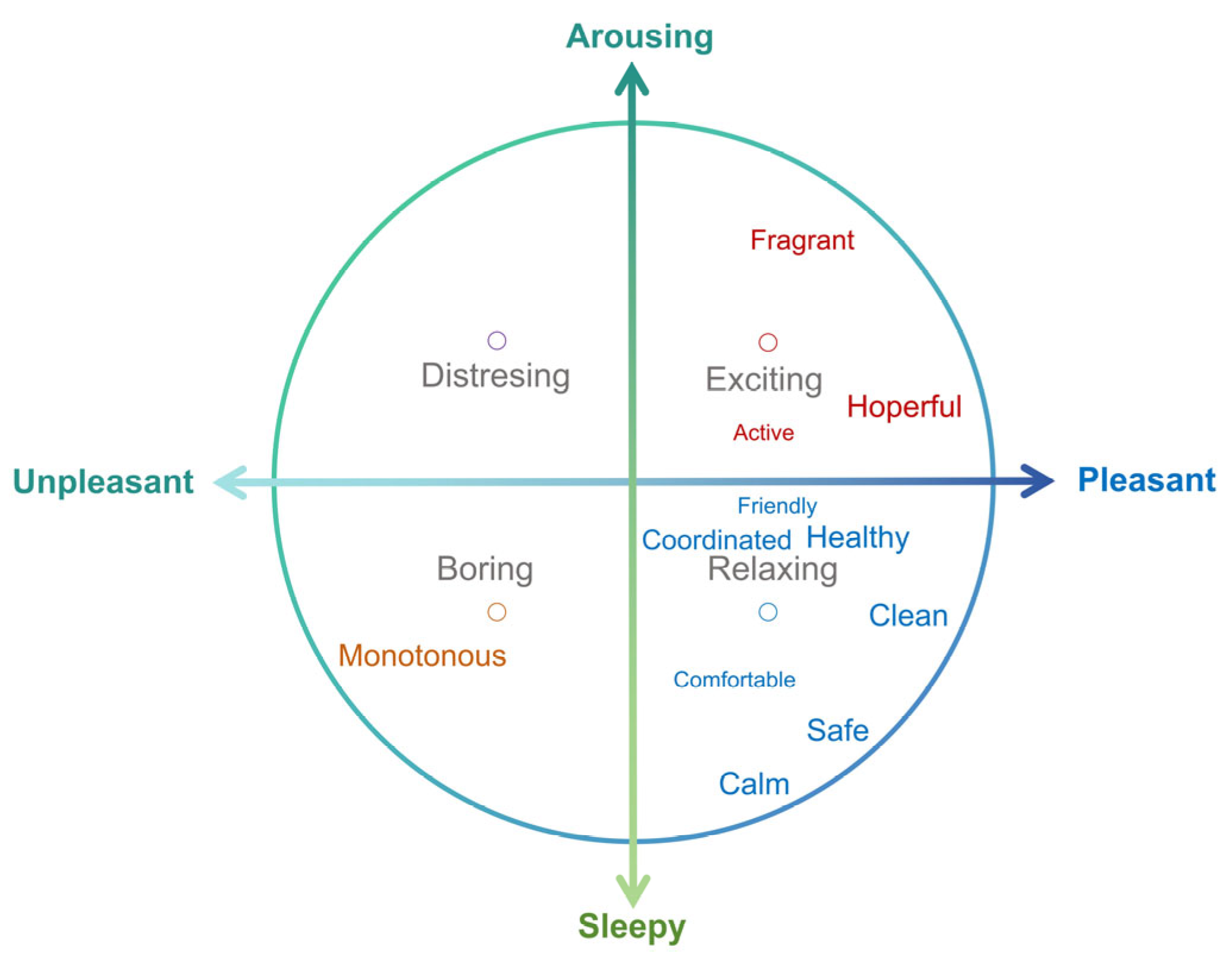

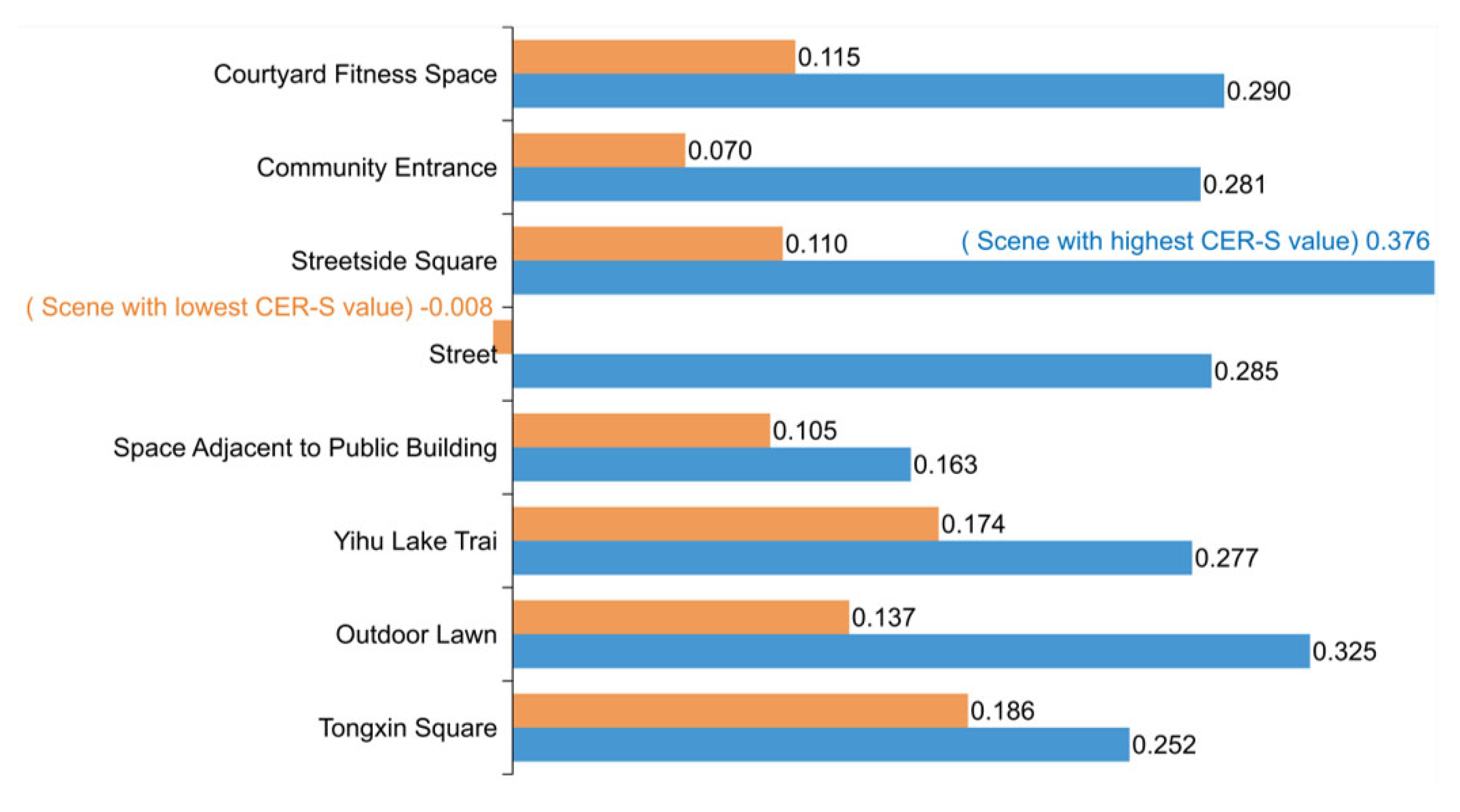
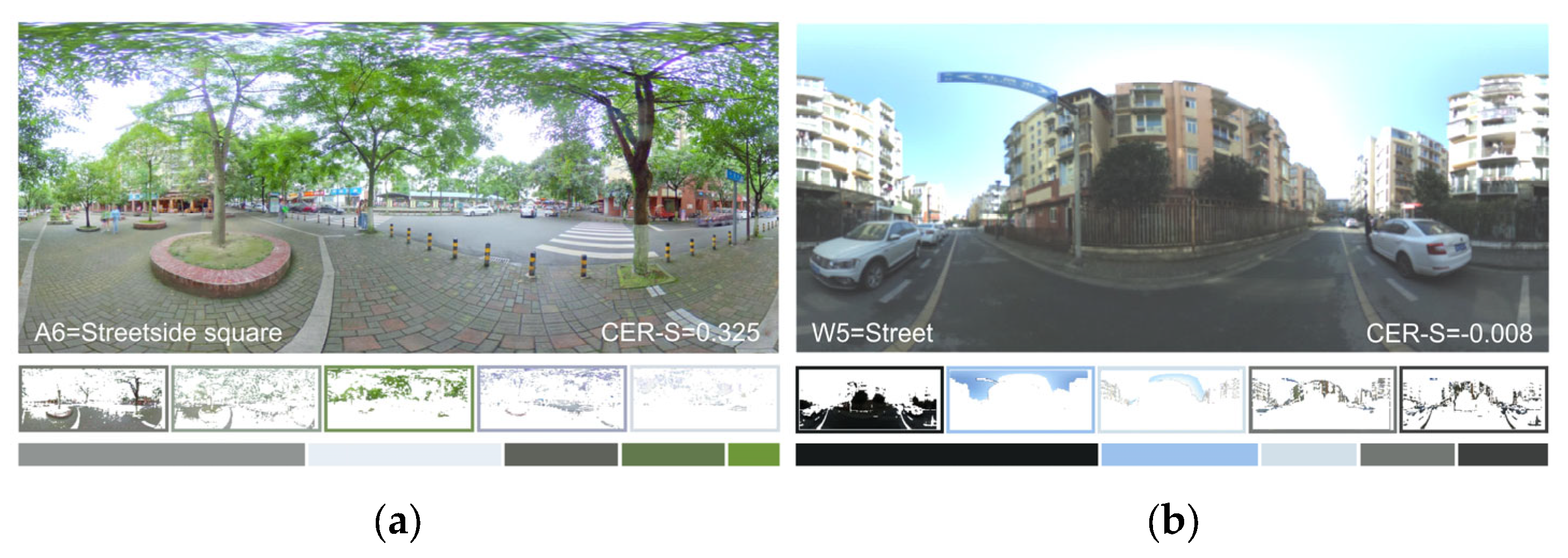
| Individual Information | Items | Categories |
|---|---|---|
| Background factors | Gender | Male = 1; Female = 2 |
| Age | 65–70 = 1; 70–75 = 2; 75–80 = 3; over 80 = 4 | |
| Educational level | Junior Secondary or Below = 1; High school or technical secondary school = 2; Junior college = 3; Bachelor degree or above = 4 | |
| Visiting factors | Walking time from residence | Less than 5 min = 1; Less than 10 min = 2; Less than 15 min = 3; Less than 30 min = 4; More than 30 min |
| Visit frequency | Once a day or more = 1; Once a week or more = 2; Once a month or more = 3; Once a year or more = 4 | |
| Time periods for visit | 6:00–10:00 a.m. = 1; 13:00–14:00 p.m. = 2; 15:00–17:00 p.m. = 3; 19:00–21:00 p.m. = 4 |
| Color Characteristics | Indicator Description |
|---|---|
| HSV indicators | H represents hue, measured by angle, with the range of 0°~360°; S represents saturation of a color, with values ranging from 0 to 1, a larger value indicates a more saturated color; V represents value or the brightness of a color, with values; ranging from 0 to 1, a larger value indicates a brighter color |
| Color area ratio | Percentage of green areas in the scene; |
| Percentage of blue areas in the scene; | |
| Percentage of gray areas in the scene | |
| Color spatial pattern | One of the color spatial patterns of dots, lines, and surfaces = 1; Two of the color patterns of dots, lines and surfaces = 2; Three of the color patterns of points, lines and surfaces = 3 |
| Individual Factors | Categories | N | Weighted % |
|---|---|---|---|
| Gender | Male | 127 | 38.5 |
| Female | 203 | 61.5 | |
| Age | 65–70 | 204 | 61.8 |
| 70–75 | 120 | 36.4 | |
| 75–80 | 5 | 1.5 | |
| >80 | 1 | 0.3 | |
| Education Level | Junior Secondary or Below | 139 | 42.1 |
| High School or Technical Secondary School | 127 | 38.5 | |
| Junior College | 50 | 15.2 | |
| Bachelor Degree or Above | 14 | 4.2 | |
| Walking time from residence | Less than 5 min | 17 | 5.2 |
| Less than 10 min | 34 | 10.3 | |
| Less than 15 min | 59 | 17.9 | |
| Less than 30 min | 217 | 65.8 | |
| More than 30 min | 3 | 0.9 | |
| Visit frequency | Once a Day or More | 69 | 20.9 |
| Once a Week or More | 85 | 25.8 | |
| Once a Month or More | 151 | 45.8 | |
| Once a Year or More | 25 | 7.6 | |
| Time periods for visit | 6:00–10:00 a.m. | 120 | 36.4 |
| 13:00–14:00 p.m. | 36 | 10.9 | |
| 15:00–17:00 p.m. | 107 | 32.4 | |
| 19:00–21:00 p.m. | 67 | 20.3 |
| Scene | Mean Of HSV Indicators | Color Area Ratios | Color Spatial Pattern | ||||
|---|---|---|---|---|---|---|---|
| Hue | Saturation | Brightness | Green | Blue | Gray | ||
| A1 | 137 | 30 | 50 | 26.80% | 20.24% | 34.64% | 3 |
| A2 | 135 | 28 | 68 | 39.65% | 35.90% | 9.92% | 3 |
| A3 | 148 | 14 | 66 | 17.13% | 47.21% | 10.70% | 1 |
| A4 | 168 | 9 | 69 | 3.67% | 36.96% | 63.04% | 2 |
| A5 | 129 | 17 | 61 | 38.83% | 24.25% | 36.92% | 3 |
| A6 | 158 | 17 | 65 | 20.69% | 25.76% | 53.55% | 2 |
| A7 | 111 | 13 | 62 | 12.34% | 22.72% | 56.05% | 2 |
| A8 | 93 | 23 | 43 | 2.20% | 23.54% | 76.45% | 2 |
| W1 | 88 | 42 | 48 | 37.79% | 41.08% | 21.12% | 2 |
| W2 | 80 | 29 | 49 | 5.60% | 48.17% | 20.88% | 3 |
| W3 | 110 | 21 | 50 | 28.50% | 36.98% | 34.53% | 2 |
| W4 | 182 | 24 | 45 | 2.80% | 34.15% | 65.84% | 2 |
| W5 | 136 | 21 | 35 | 8.20% | 10.67% | 81.13% | 2 |
| W6 | 194 | 25 | 45 | 6.14% | 33.72% | 60.13% | 2 |
| W7 | 147 | 22 | 42 | 10.96% | 17.22% | 71.86% | 2 |
| Paired Items | Pair (Mean ± Standard Deviation) | Difference Value (Pair 1 − Pair 2) | t | p | |
|---|---|---|---|---|---|
| Pair 1 | Pair 2 | ||||
| CER values for autumn scenes paired CER values for winter scenes | 3.61 ± 51.53 | −0.06 ± 46.91 | 3.67 | 2.115 | 0.038 * |
| Positive CER-R Value | Gender | Age | Education Level | Walking Time from Residence | Visit Frequency | ||
|---|---|---|---|---|---|---|---|
| Gender | Coefficients | 0.013 | |||||
| Significance | 0.772 | ||||||
| Age | Coefficients | 0.060 | 0.048 | ||||
| Significance | 0.183 | 0.385 | |||||
| Education level | Coefficients | 0.219 ** | −0.068 | 0.110 * | |||
| Significance | 0.000 | 0.192 | 0.033 | ||||
| Walking time from residence | Coefficients | −0.151 ** | 0.126 * | 0.087 | −0.082 | ||
| Significance | 0.000 | 0.016 | 0.094 | 0.096 | |||
| Visit frequency | Coefficients | 0.176 ** | −0.004 | 0.089 | 0.113 * | 0.018 | |
| Significance | 0.000 | 0.942 | 0.079 | 0.018 | 0.716 | ||
| Time period of visit | Coefficients | 0.061 | −0.028 | −0.061 | −0.044 | −0.089 | −0.015 |
| Significance | 0.143 | 0.580 | 0.227 | 0.357 | 0.066 | 0.747 | |
| Variables | Unstandardized Beta | Standardized Beta | t | Sig. | Collinearity Statistics | ||
|---|---|---|---|---|---|---|---|
| Tolerance | VIF | ||||||
| (constant) | 10.566 | 3.316 | 3.186 | 0.002 | |||
| Education level | 2.989 | 0.754 | 0.207 | 3.965 | 0.000 | 0.979 | 1.022 |
| Walking time from residence | −2.173 | 0.711 | −0.158 | −3.056 | 0.002 | 0.995 | 1.005 |
| Visit frequency | 2.771 | 0.657 | 0.219 | 4.217 | 0.000 | 0.983 | 1.018 |
| Positive CER-S Value | Hue | Saturation | Brightness | Color Area Ratio of Three Colors | ||||
|---|---|---|---|---|---|---|---|---|
| Green | Blue | Gray | ||||||
| Hue | Coefficients | −0.103 | ||||||
| Significance | 0.054 | |||||||
| Saturation | Coefficients | −0.153 ** | −0.411 ** | |||||
| Significance | 0.004 | 0.000 | ||||||
| Brightness | Coefficients | 0.358 ** | 0.174 ** | −0.507 ** | ||||
| Significance | 0.000 | 0.001 | 0.000 | |||||
| Color area ratio of green | Coefficients | 0.233 ** | −0.297 ** | 0.383 ** | 0.293 ** | |||
| Significance | 0.000 | 0.000 | 0.000 | 0.000 | ||||
| Color area ratio of blue | Coefficients | −0.124 * | −0.155 ** | 0.199 ** | 0.146 ** | 0.017 | ||
| Significance | 0.024 | 0.005 | 0.000 | 0.008 | 0.762 | |||
| Color area ratio of gray | Coefficients | −0.186 ** | 0.358 ** | −0.368 ** | −0.418 ** | −0.684 ** | −0.623 ** | 0.060 |
| Significance | 0.000 | 0.000 | 0.000 | 0.000 | 0.000 | 0.000 | 0.258 | |
| Color spatial pattern | Coefficients | −0.186 ** | −0.278 ** | 0.370 ** | 0.002 | 0.393 ** | −0.183 ** | |
| Significance | 0.000 | 0.000 | 0.000 | 0.969 | 0.000 | 0.001 | ||
| Variables | Unstandardized Beta | Standardized Beta | t | Sig. | Collinearity Statistics | |
|---|---|---|---|---|---|---|
| Tolerance | VIF | |||||
| (constant) | 0.363 | 1.801 | 0.073 | |||
| VBrightness | 0.008 | 0.363 | 3.931 | 0.000 | 0.283 | 3.535 |
| Color area ratio of blue | −1.024 | −0.468 | −4.757 | 0.000 | 0.249 | 4.020 |
| Color area ratio of gray | −0.004 | −0.461 | −3.598 | 0.000 | 0.247 | 6.822 |
| Main Findings | Countermeasures |
|---|---|
| The elderly had strongest emotions of cleanliness and health | Maintaining blue-green space and its use, clean water, neat trees. |
| The elderly described the color landscapes in the community outdoor spaces as monoton | Enrich the color landscape with a combination of layers to enhance the effect of color arousal, active sense, and exciting emotion. |
| The positive color emotions of the elderly were stronger for autumn scenes than for winter | Emphasize the creation of color diversity through increasing the colorful foliage of flowers and plants in winter. |
| Education level positively influenced elderly residents’ CER value | Target most elderly with a lower education level, focus on the creating the perception of security, relaxation, and other basic emotions. |
| Visit frequency positively influenced elderly residents’ CER value | Increase the number of color landscape nodes to attract more elderly residents to engage in outdoor activities. |
| Walking time from residence negatively influenced elderly residents’ CER value | Enhance the connectivity of daily walking paths for the elderly to improve the negative experience of walking tiredness. |
| Brightness positively influenced elderly residents’ CER value | Control the colors in the community outdoor spaces at an average brightness level of medium or medium-high. |
| Color area ratio of blue negatively influenced elderly residents’ CER value | In spaces with excessively open sky, use plant and artificial landscapes to secondary limit and enclose the spaces. |
| Color area ratio of gray negatively influenced elderly residents’ CER value | Reduce the proportion of gray in paving, increase colorful permeable paving to reduce the dull emotional experience. |
Disclaimer/Publisher’s Note: The statements, opinions and data contained in all publications are solely those of the individual author(s) and contributor(s) and not of MDPI and/or the editor(s). MDPI and/or the editor(s) disclaim responsibility for any injury to people or property resulting from any ideas, methods, instructions or products referred to in the content. |
© 2024 by the authors. Licensee MDPI, Basel, Switzerland. This article is an open access article distributed under the terms and conditions of the Creative Commons Attribution (CC BY) license (https://creativecommons.org/licenses/by/4.0/).
Share and Cite
Zhang, C.; Chen, Y.; Dewancker, B.J.; Shentu, C.; Tian, H.; Liu, Y.; Wan, J.; Zhang, X.; Li, J. Emotional Landscapes in Urban Design: Analyzing Color Emotional Responses of the Elderly to Community Outdoor Spaces in Yi Jie Qu. Buildings 2024, 14, 793. https://doi.org/10.3390/buildings14030793
Zhang C, Chen Y, Dewancker BJ, Shentu C, Tian H, Liu Y, Wan J, Zhang X, Li J. Emotional Landscapes in Urban Design: Analyzing Color Emotional Responses of the Elderly to Community Outdoor Spaces in Yi Jie Qu. Buildings. 2024; 14(3):793. https://doi.org/10.3390/buildings14030793
Chicago/Turabian StyleZhang, Chengyan, Youjia Chen, Bart Julien Dewancker, Chaojie Shentu, Hao Tian, Yutong Liu, Jiangjun Wan, Xinyue Zhang, and Jinghui Li. 2024. "Emotional Landscapes in Urban Design: Analyzing Color Emotional Responses of the Elderly to Community Outdoor Spaces in Yi Jie Qu" Buildings 14, no. 3: 793. https://doi.org/10.3390/buildings14030793
APA StyleZhang, C., Chen, Y., Dewancker, B. J., Shentu, C., Tian, H., Liu, Y., Wan, J., Zhang, X., & Li, J. (2024). Emotional Landscapes in Urban Design: Analyzing Color Emotional Responses of the Elderly to Community Outdoor Spaces in Yi Jie Qu. Buildings, 14(3), 793. https://doi.org/10.3390/buildings14030793





